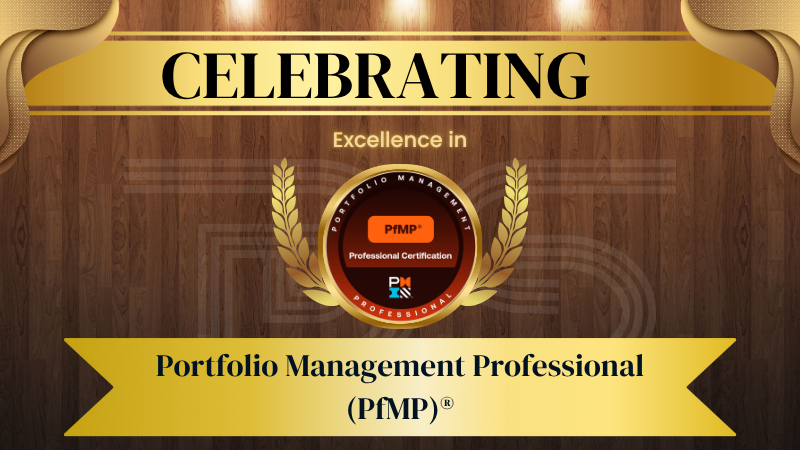
by DharamCW | Jun 14, 2025 | Leadership in Project Management, PMI Certification Success Stories, Professional Resilience and Inspiration Stories
🎉 Celebrating PfMP Success: March 2025 – May 2025! 🌟
A huge congratulations to all professionals who achieved their Portfolio Management Professional (PfMP) certification with the support of vCare Project Management! 🎯
🚀 We are thrilled to share that the global PfMP® community has now grown beyond 2,100+ certified professionals, with 176 new PfMP®s across 36 countries who trusted vCare’s expertise in their journey.
This milestone reflects the effectiveness of our structured training, mentorship, and exam preparation resources. We are proud to be part of your success and look forward to guiding more professionals to achieve excellence in portfolio management.
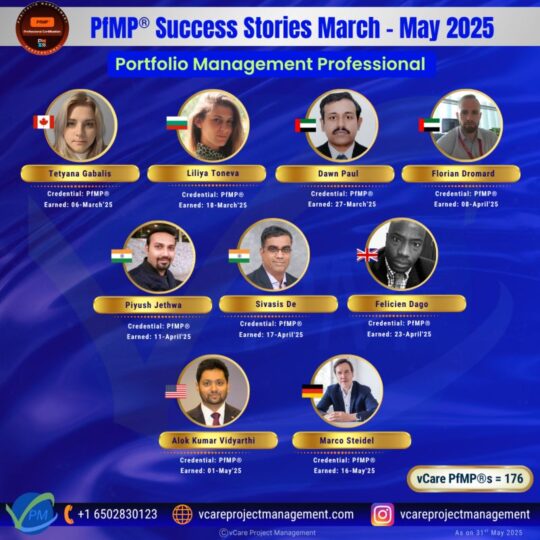
176 new PfMPs certified across 36 countries! Congratulations from vCare Project Management – March to May 2025.
🔹 Ready to elevate your portfolio management career?
Let’s make your PfMP® journey a success! DM me for guidance.
📌 Explore Our PfMP® Programs:
🌐 Online Training → http://bit.ly/39jOZSf
🏛 Direct Training → http://bit.ly/38er2M3
📌 Join Our PfMP® Community:
PfMP4U LinkedIn Group → http://bit.ly/31P7GKR
📌 Essential PfMP® Study Materials:
PfMP Pathfinder – https://bit.ly/35j9Dli
The Complete Reference Guide for PfMP Certification – https://bit.ly/3pU4ud5
PfMP Challenger Mock Exam 1 | Exam Simulator – https://bit.ly/3KKZkv3
PfMP Challenger Mock Exam 2 | Exam Simulator – https://bit.ly/3VlI5FH
PfMP Challenger Mock Exam 3 | Exam Simulator – https://bit.ly/3VNrfRL
PfMP Challenger Gold (Mock Exams 1 to 3) | Exam Simulator – https://bit.ly/3KCjbNh
📌 Register for our Upcoming Webinars:
🔹 Strategic Leadership & Operational Excellence featuring Jay Brough – bit.ly/41sSraX
🔹 Unlock PMO Success with PMI-PMOCP™: A Special Session with Dharam & Kim – bit.ly/3Sp9h5l
📌Need expert guidance? Book a free consultation with me: http://talktodharam.com
🎥 Stay Updated with Project Management Insights!
🔔 Subscribe to vCare Project Management YouTube Channel: https://bit.ly/2YF0wJl
🎙 Follow My Podcasts & Expert Interviews: https://bit.ly/2NDY8wd
#PfMP #PortfolioManagement #PfMPCertification #vCarePfMP #PMICertification #ProjectManagement #CareerGrowth #SuccessStory #GlobalCommunity #DharamSingh #PfMP4U #PfMPTraining #PfMPPathfinder #Leadership #MentorshipMatters #PfMPChallenger #CertificationJourney #PortfolioSuccess #PfMPMentoring #StrategyExecution
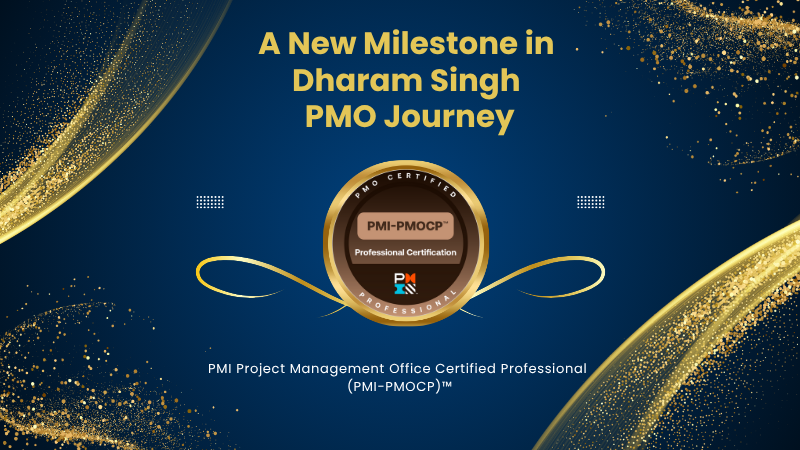
by DharamCW | Jun 13, 2025 | Professional Resilience and Inspiration Stories
🌟 What keeps you going when the path is tough, unclear, and constantly evolving?
For me, it has always been a blend of Ikigai –> the reason for being and Kaizen –> continuous improvement. Today, I’m humbled and excited to share that I have officially earned the PMI Project Management Office Certified Professional (PMI-PMOCP™) credential from the Project Management Institute.
👉 https://lnkd.in/gh58pKjd
This certification marks not just a personal milestone, but a reaffirmation of what matters most — delivering value-driven, strategically aligned PMO leadership in a rapidly transforming world.
💡 I extend my heartfelt gratitude to the incredible project, program, and portfolio management professionals around the globe whose perseverance, curiosity, and spirit of excellence have continuously inspired me. Many of you have been part of my learning journey — as mentors, peers, and students. Thank you!
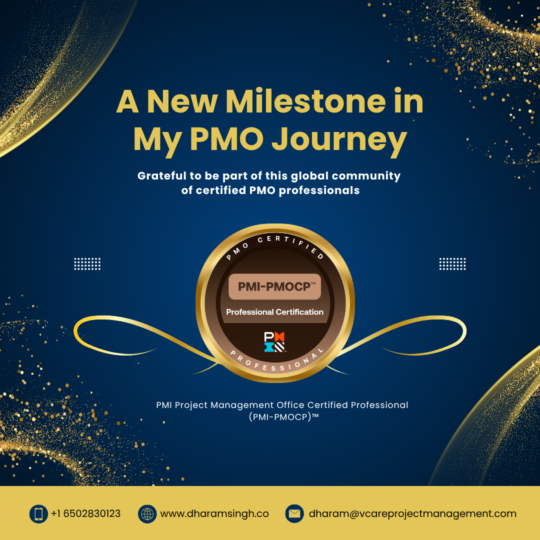
Dharam Singh earns the PMI-PMOCP™ credential — Project Management Office Certified Professional
🎤 To celebrate this milestone, I invite you to an upcoming awareness session:
Unlock PMO Success with PMI-PMOCP™: A Special Session with Dharam & Kim
🗓️ Date: July 2nd, 2025
🕙 Time: 10:00 AM – 11:00 AM PDT
🎙️ With Kim Marcelliano, Senior Product Manager at Project Management Institute
🔗 Register here : https://bit.ly/3Sp9h5l
📚 If you are looking to become PMI-PMOCP™ certified, we’re launching PMI-PMOCP Certification Training Programs:
🧭 Direct Bootcamps Dallas, Texas, United States:
• 27–28 August: https://bit.ly/3Zqlgn2
• 29–30 September: https://bit.ly/4drorAA
🌐 Online Bootcamps:
• 30–31 August: https://bit.ly/4jbZGcY
• 6–7 September: https://bit.ly/4mrfBHo
🚀 I believe PMOs are no longer just governance engines — they are strategic enablers. With frameworks like PMI-PMOCP™, we now have a global standard to guide that transformation.
🔍 What role do you see PMOs playing in the AI-driven, strategy-focused organizations of tomorrow? Would love to hear your thoughts.
🎙️ Got questions about your Project Management career or PMI certifications?
Book your FREE 15-min session with me at 👉 www.talktodharam.com
📞 Contact Us
Call: 650-283-0123
Email: info@vcareprojectmanagement.com
🎧 Subscribe & Stay Ahead
Webinars & Success Stories: https://bit.ly/2YF0wJl
Podcasts & Interviews: https://bit.ly/2NDY8wd
#PMOCP #PMICertified #PMOLeadership #StrategicPMO #DharamSingh #vCareProjectManagement #Kaizen #Ikigai #PMOTransformation #ProjectManagement #PMICertification #MentorshipMatters #FutureOfWork #ContinuousLearning #PMOCareer #AIandPMO #LeadershipMilestone #CareerSuccess #PMIBootcamp #PMITraining

by DharamCW | Jun 10, 2025 | vCare PMI Certification Training Classes
🎯 Ready to level up your project management career?
🚀 Join us in Dallas, USA, for the PMP® Direct Bootcamp from 3rd to 6th July 2025, led by globally acclaimed mentor Dharam Singh PfMP, PgMP, PMP, PMOCP, PBA, SP, RMP, ACP, DASM, DASSM, PMI-ATP.
🔍 This immersive in-person bootcamp is designed for professionals aiming to crack the PMP exam with confidence and walk away with 35 PDUs/Contact Hours!
🔗 Register Now: https://bit.ly/3WCSuy4
📅 Dates: July 3 – 6, 2025
⏰ Timing: 9 AM – 5 PM (CDT)
📍 Location: Dallas, USA
✅ What’s Included?
– Access to PMI Authorized PMP Exam Prep platform
– PMP® application and audit assistance
– Proven exam strategies and expert tips
– 35 PDUs / Contact Hours
👤 Mentor: Dharam Singh PfMP, PgMP, PMP, PMOCP, PBA, SP, RMP, ACP, DASM, DASSM, PMI-ATP – a trusted name in PMP®, PgMP®, and PfMP® success journeys, with 30+ years of global experience in project leadership.
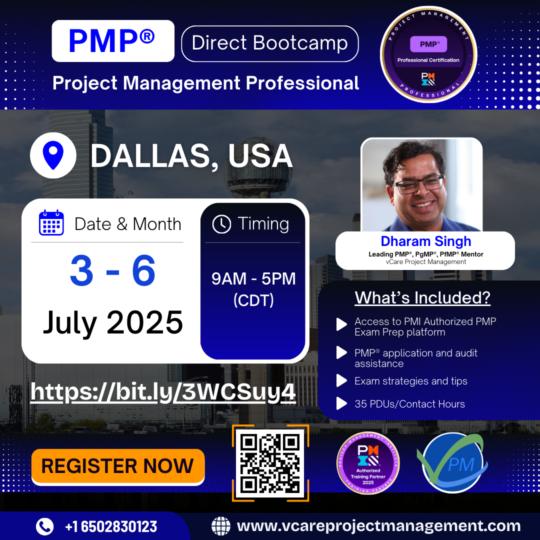
Prepare for PMP success! Join Dharam Singh in Dallas from July 3–6, 2025 for a live bootcamp and earn 35 PDUs.
📞 For more info: +1 650 283 0123
🌐 https://lnkd.in/fyGudKQ
View our upcoming PMP Programs
Online – https://bit.ly/2BU0mFp
Direct – http://bit.ly/3ic7GRF
Join our PMP4U LinkedIn Group for the latest updates – https://bit.ly/30gV5QX
Explore our useful PMP Study Materials:
vCare PMP Exam Simulator – 1 Year Access: https://bit.ly/41BFc6A
PMBOK Guide | 7th Edition: http://bit.ly/2Z2Zn1b
For more insights into project management certification, training, and career development, book a personalized, obligation-free consultation session with Dharam Singh at http://talktodharam.com
🔥 Seats are limited. Don’t miss your chance to prepare the right way – directly with one of the best!
#PMPBootcamp #Dallas2025 #PMPCertification #PMPTraining #DharamSingh #vCareProjectManagement #PMPMentor #ProjectManagement #PMIATP #35PDUs #PMPUSA #PMPExamPrep #PMPStudyPlan #CareerGrowth #PMPCoach #PMI #PMPApplication #PMPContactHours
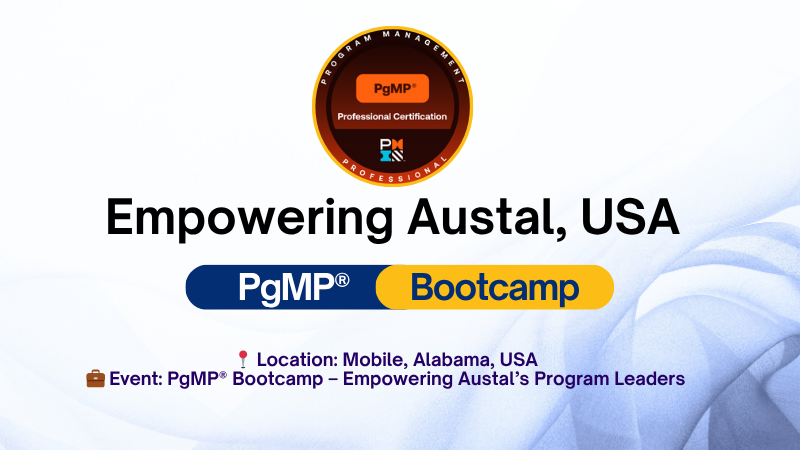
by DharamCW | Jun 3, 2025 | Uncategorized
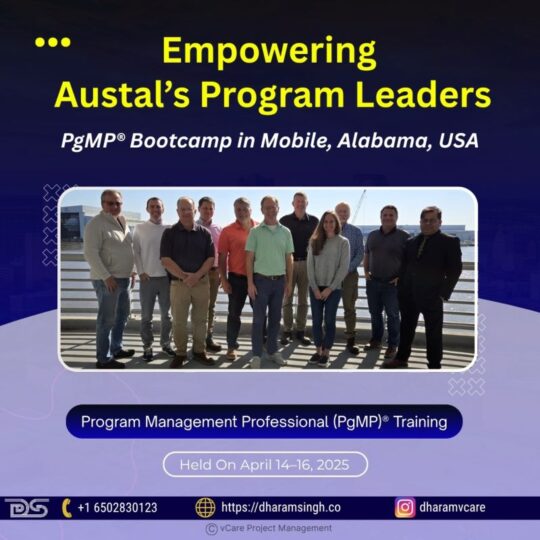
Austal USA program managers engaging in PgMP Bootcamp sessions focused on strategic transformation and enterprise alignment.

by DharamCW | May 31, 2025 | vCare PMI Certification Training Classes
I’m grateful for the opportunity to support professionals preparing for their PgMP and PfMP certifications — now through in-person bootcamps in Dallas, Texas, United States this June 2025.
Over the years, I’ve had the privilege to work with dedicated program and portfolio leaders across the globe. Together, we’ve seen 555+ professionals achieve their PgMP® and 176+ attain the PfMP® — milestones made possible not just through mentorship, but through their unwavering perseverance and commitment.
Every success story reinforces the power of community, shared learning, and collective growth. If you’re aspiring to be part of this growing elite certification community, I’d be honored to support your journey.
This June, I’ll be facilitating two small-group, in-person sessions designed to help professionals navigate the complexities of:
🔹 Program Management Certification Training (PgMP®)
📅 20–22 June 2025, 9 AM – 5 PM CDT
🔗 https://bit.ly/3BGZeUh
🔹 Portfolio Management Certification Training (PfMP®)
📅 27–29 June 2025, 9 AM – 5 PM CDT
🔗 https://bit.ly/3ByLdrs
If you’re working toward the PgMP® or PfMP® credential, or seeking clarity on the path forward — I welcome you to join us. Whether you attend to prepare, reflect, or strengthen your strategic lens, I’ll be there to support your learning every step of the way.
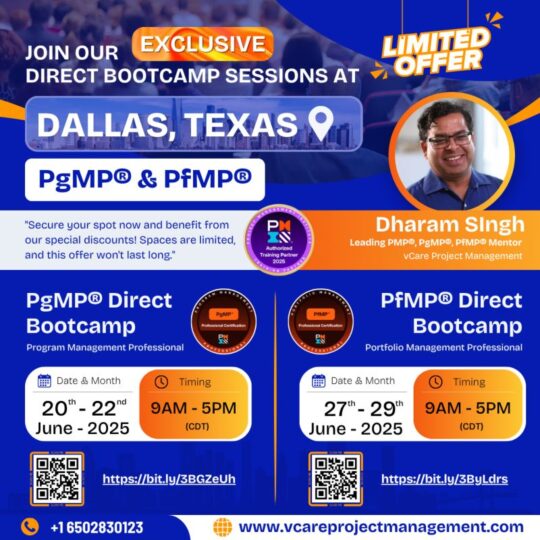
Join the elite certification journey! In-person PgMP & PfMP bootcamps with Dharam Singh in Dallas – June 2025.
🚀 Exclusive Offers & Discounts on Training Programs!
👉 Check out special offers here: https://bit.ly/3jWVepD
🎯 Not Sure If You’re Ready? Let’s Talk!
💡 Book a FREE 15-min Consultation with Me: 🔗 http://talktodharam.com
📺 Stay Ahead in Project Management!
🔔 Subscribe to vCare Project Management YouTube Channel: https://bit.ly/2YF0wJl
🎙 Follow My Podcasts & Expert Interviews: https://bit.ly/2NDY8wd
Let’s continue building value together — for ourselves, our organizations, and the broader project management profession.
#PgMP #PfMP #PMICertifications #ProgramManagement #PortfolioManagement #DallasBootcamp #PMIATP #LeadershipMentoring #DharamSingh #vCareProjectManagement #StrategicLeadership #USBootcamp #ProfessionalGrowth #PgMPMentoring #PfMPMentoring #EliteCertification #CertificationSuccess #MentorshipMatters











At Austal USA, that question sparked a new journey — and the results were truly inspiring.
📍 Location: Mobile, Alabama, USA
💼 Event: PgMP® Bootcamp – Empowering Austal’s Program Leaders
From April 14–16, 2025, I had the privilege of coaching an exceptional group of program leaders at Austal, a globally respected name in shipbuilding and defense.
What stood out most? Their openness to rethink, relearn, and realign their leadership with enterprise strategy. Over three dynamic days, we explored not just the PgMP® framework, but real-world applications — leading with purpose, precision, and program discipline.
Each conversation, case study, and challenge solved reinforced why program managers are the bridge between vision and value delivery.
🌟 To the Austal USA team: your professionalism and enthusiasm made this bootcamp truly rewarding. I’m grateful for the opportunity to contribute to your growth and leadership journey. Special thanks to PMTraining for making this collaboration possible and for supporting organizations in upskilling their program management talent.